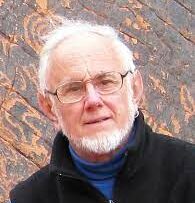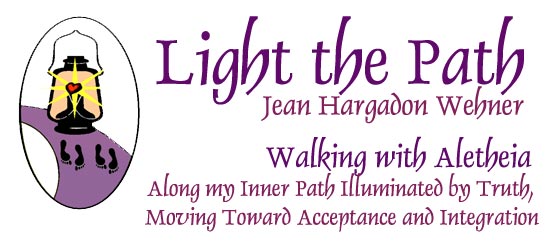Walking with Aletheia is about Jean Hargadon Wehner’s most credible journey dealing with the sexual abuse she received, first by a great uncle and then by a network of pedophile priests and others from her Catholic high school in Baltimore. Her dissociation from this horrific sexual abuse lasted until the age of 27 when she gradually began to remember the repressed memories, thus beginning the slow healing journey that continues even now as she ages into her late sixties. This story of emotional terror and pain describes her ways of finding the strength to deal with these emotions. She is now writing and speaking out, offering support to others in their remembering and healing as she educates therapists and other professionals about her journey. Her exceptionally strong support system included her loving and patient husband Mike, several of her siblings, and eventually her parents, her two children, and her many counselors, therapists and her spiritual guides. Her story becomes a very powerful example from which others who have been abused can find strength, and for therapists to find deeper understanding of the therapeutic process.
Most important in uncovering and healing her abuse and pain is her continued practice of a personal quiet time of meditation and prayer, quiet time that was shared, listened to, and supported by her support group and therapists. Though I have worked as a psychologist with many victims of sexual abuse, helping them uncover and heal fragments of their uncovered memories, Jean brings together a much broader and more complete picture of her journey. Writing her story is so important in her personal healing, but also for others recovering from sexual abuse, freeing them from the feelings of guilt and responsibility of victimhood, and finding support in coming out of the emotional prison of the abused.
Her process of uncovering and healing includes the value of her time in quiet meditation, identifying her protective dissociated personas or aspects of herself as a young girl, and calling upon her spirit guides as they arise both from within her protective dissociation from the abuse, and also from her strength in facing the abuse. The final step in healing is for the integration of these personas with her “self.”
Walking with Aletheia is, in part, the story of uncovered repressed abuse, forgotten due to the self-protective mechanism of dissociation. Uncovering the abuse allows her to begin on the journey of healing. Throughout the book, Jean presents vignettes, which have given her direction in healing, most that flowed from her time of “quiet,” from her unconscious, many in the powerfully deep language of metaphor. This healing was led or supported by her numerous spirit guides, in the forms of humans and animals. Though this journey took her away from the Catholic Church and her loss of faith in the church, it took her into a deeper spiritual place of healing.
Jean’s sexual abuse began at the age of three years at the hands of her great uncle with whom she interacted with while spending overnight weekend visits with her great aunt.
Jean entered Archbishop Keough High School in 1967 when she was 14. There, three more years of abuse occurred, only this time at the hands of clergy. Her vivid description of her feelings of fear and pain that explains her dissociation from this sexual abuse can best be described only by her in her own words.
Uncovering Repressed Memories and Healing
Though her sexual abuse ended upon graduation from high school, Jean’s memories of this abuse did not start to return until 1980 when she was 27 years old. From 1996 to around 2014, Jean, following the loss of a legal case against the archdiocese because of a statute of limitations failure, and the untimely death of her husband, withdrew from any public exposure, but continued in her personal journey in silence. In 2014, she was approached by Tripod Media to participate in a documentary called The Keepers. It was about the murder of Cathy Cesnik, a teaching nun at Keough, and about accusations of sex abuse of the students at the high school. In this documentary, released in 2017, Jean was publicly able to fully emerge as “Jean Hargadon Wehner”. While participating in this production, Jean continued to recover memories and heal. Since The Keepers’ release, she has been frequently asked to speak to various groups, and she testified in the Maryland legislature regarding the issue of the statute of limitations.
Jean reports, “For many years, my practice was to sit quietly in prayer and meditation, including some journaling and dialogue with Jesus. I did not have a special physical, prayer space; I just took time to sit with my journal and follow my heart. Many times, my heart would lead me to a period of reflection and meditation; I would quiet down and let myself be still. Of course, the normal chatter was in my brain, and the thoughts seemed like they would not stop, but with time I got beyond that.” During this time of quiet, her memories of the abuse continued to surface.
Many of the vignettes were of recovering memories, memories that sometimes took weeks if not months to completion. These vignette experiences were most powerful in her healing process, especially when she shared them with her therapists and support group, those who wisely supported and encouraged her in this process. These experiences were often dreamlike visions in the language of metaphor, the language experienced when going beyond the rational mind and into the unconscious.
Spirit Guides & Integrating Her Personas
Jean relates her experiences during her quiet with spirit guides, who were protectors. Imagination comes from beyond the five senses and thus comes from within the person; it reflects an important personal dimension. Therefore, all images that arise in her quiet are parts of her and are spirit guides. Such visions often open the door to the past or are predictors of the future, but the visions frequently reflect progress in working towards some goal. Certain spirit guides provided Jean with protection and strength, guides that rose above those other guides she experienced in her recovery of memories. Many of the ones that arose in her experiences of quiet were specific to the struggles she was going through at the time.
Many of the guides are protectors of Jean’s personas. Each persona is an aspect of Jean that separated from her in the protective process of dissociation in her struggle with the abuse. They need to eventually be reincorporated within her for healing.
As her experiences unfolded over time, and some took weeks and even months for resolution, they followed no logical linear time-line. She never knew what experience or fragment of an experience might arise next. The unconscious mind is not logical but time-free as nighttime dreams are free of time, e.g. in a nighttime dream you may find yourself as an adult in your childhood home or visa-versa. The time-free nature of these visions from the unconscious is the power of these visions in healing. Each vignette opens new doors in the process of healing, and with her extensive support group listening to her visions, healing progressed.
In the process of therapy, Jean’s protective personas were separate from her, created in her dissociation from the abuse. For healing, these personas need to again become one with her. This reintegration reflects the final step to wholeness, of becoming one within herself. Only with time can these personas dissolve into Jean. The healing of the adult Jean continues with the integration of each of her personas that has provided her with protection and growth since her teenage years.
Jean’s vision experiences while in her “quiet” state may seem quite strange to many readers, but these experiences of connecting with her unconscious are very central and important in healing. They may arise in many different ways. In my book Applying the Constructivist Approach to Cognitive Therapy: Resolving the Unconscious Past, I attempt to summarize many of these ways: dreamwork, hypnotic and ecstatic trance, guided-imagery, free-association, waking morning reverie, and self-hypnosis. Jean’s “quiet” opens for her the door to her unconscious, uncovering unconscious repressed memories and providing a map for healing. As mentioned earlier, the metaphoric nature of these experiences is the typical language of the unconscious. Apparently, Jean on her own, from within herself, discovered and learned to value the power of these self-hypnotic experiences for healing. She has exhibited in her “quiet” practice an exceptional personal strength, that she is teaching others in her writing and speaking engagements, that can benefit all. Walking with Aletheia is a most important book of healing.

Nicholas E. Brink, PhD
Author, The Power of Ecstatic Trance: Practices for Healing, Spiritual Growth, and Accessing the Universal Mind (2013); Applying the Constructivist Approach to Cognitive Therapy, Resolving the Unconscious Past (2019); , Grendel and His Mother: Healing the Traumas of Childhood Through Dreams, Imagery and Hypnosis (2019);
Ecstatic Soul Retrieval: Shamanism and Psychotherapy (2017); and Loki’s Children: A Healing Story of Antiquity, Shamanism and Psychotherapy (2020); andBaldr’s Magic: The Power of Norse Shamanism and Ecstatic Trance (2014)
.
